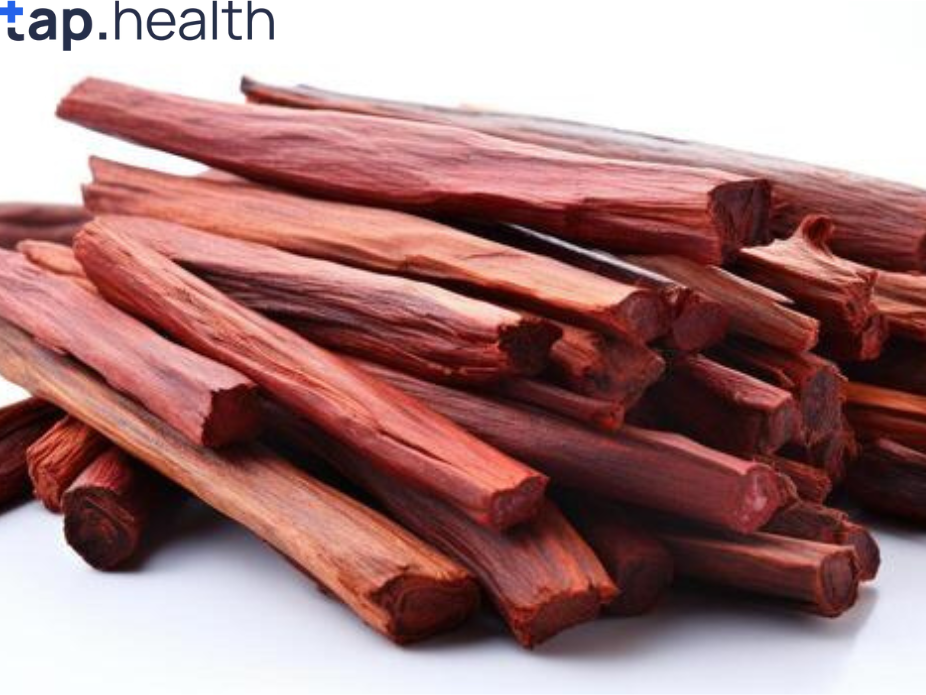Red Sandalwood (Pterocarpus santalinus) is a precious tree native to India, known for its vibrant red heartwood. While it has a long history of use in traditional Indian medicine, red sandalwood is now gaining attention worldwide for its numerous health benefits. From skincare to stress relief, this versatile ingredient can work wonders for your body and mind.
In this comprehensive guide, we will explore the health benefits of red sandalwood, how to incorporate it into your wellness routine, and some practical ways to use it. If you’re curious about red sandalwood and how it can enhance your life, read on!
What is Red Sandalwood?
Red Sandalwood, often referred to as Rakta Chandan in Sanskrit, is a type of sandalwood that comes from the heartwood of the Pterocarpus santalinus tree. This tree is native to the southern part of India, particularly in regions like Andhra Pradesh and Tamil Nadu. Unlike the more commonly known white sandalwood (Santalum album), red sandalwood is prized for its deep red color and unique properties.
The wood has been used in Ayurvedic medicine, as well as in rituals and religious ceremonies. Its rich, earthy aroma and potent healing properties make it an important herb in traditional practices.
Health Benefits of Red Sandalwood
1. Red Sandalwood for Skin Health
One of the most popular uses of red sandalwood is in skincare. Thanks to its anti-inflammatory, antimicrobial, and antioxidant properties, it is often used to treat a variety of skin issues.
Reduces Acne and Pimples
Red sandalwood is known for its ability to control acne. The wood contains compounds that help reduce inflammation, kill bacteria, and prevent the clogging of pores. Applying red sandalwood powder mixed with water or rose water can create a paste that can be applied directly to acne-prone areas.
Evens Out Skin Tone
If you have pigmentation, dark spots, or uneven skin tone, red sandalwood can help. Its skin-brightening properties help lighten blemishes and promote a uniform skin tone. Regular use of red sandalwood paste or oil can gradually reduce discoloration and leave your skin looking radiant.
Soothes Skin Irritation
The soothing properties of red sandalwood make it an excellent remedy for irritated skin. Whether you have sunburns, rashes, or insect bites, a red sandalwood paste can provide immediate relief by reducing inflammation and calming the skin.
2. Red Sandalwood for Anti-Aging
Red sandalwood contains antioxidants that protect the skin from the damage caused by free radicals. Free radicals accelerate the aging process by damaging skin cells and tissues. By applying red sandalwood regularly, you can prevent wrinkles, fine lines, and sagging skin.
Firms the Skin
Red sandalwood can also improve the elasticity of the skin. It tightens the skin and makes it appear firmer. This is why it’s commonly included in anti-aging creams and serums.
Reduces Dark Circles
If you have dark circles under your eyes, red sandalwood can be effective in reducing them. Its cooling properties help soothe tired eyes, while the anti-inflammatory effects work to lighten the dark circles over time.
3. Red Sandalwood for Stress Relief and Relaxation
In traditional Indian medicine, red sandalwood is known to have calming and relaxing effects on the mind. Its aromatic properties are used to reduce stress, anxiety, and depression.
Aromatherapy Benefits
The calming aroma of red sandalwood oil can help reduce mental fatigue and provide emotional balance. Using red sandalwood essential oil in a diffuser can help promote a sense of relaxation and peace. You can also add a few drops of red sandalwood oil to your bathwater to relax your muscles and mind after a long day.
Improves Sleep Quality
If you’re struggling with insomnia or restless sleep, red sandalwood may help. The soothing properties of red sandalwood can help promote a restful night’s sleep by calming the mind and reducing anxiety before bedtime.
4. Red Sandalwood for Respiratory Health
Red sandalwood has been traditionally used to treat various respiratory conditions, including asthma, cough, and cold.
Helps in Cough Relief
Red sandalwood’s anti-inflammatory and soothing properties can help calm the airways and reduce irritation caused by cough. Consuming red sandalwood powder mixed with honey can provide relief from throat discomfort and coughing.
Fights Respiratory Infections
The antimicrobial properties of red sandalwood also make it effective in fighting respiratory infections. By purifying the air and soothing the respiratory tract, it helps in reducing symptoms associated with respiratory conditions.
5. Red Sandalwood for Detoxification
Red sandalwood helps detoxify the body by eliminating toxins. It promotes better circulation, enhances liver function, and purifies the blood.
Detoxifies the Skin
By promoting better blood circulation, red sandalwood helps to flush out toxins through the skin, leaving it clear and healthy.
Improves Liver Health
Red sandalwood’s detoxifying properties extend to the liver as well. A clean liver is crucial for overall health, as it helps in processing and eliminating waste from the body. Red sandalwood helps support liver function, preventing the buildup of harmful toxins.
How to Use Red Sandalwood
1. Red Sandalwood Powder for Skincare
To harness the skin benefits of red sandalwood, you can use red sandalwood powder in different ways. Here’s how:
Face Pack for Acne: Mix 1 tablespoon of red sandalwood powder with water or rose water to form a paste. Apply it to the face and leave it on for 15-20 minutes before washing it off.
Face Pack for Skin Tone: Mix red sandalwood powder with milk or honey to create a thick paste. Apply it to the face and leave it on for 15-20 minutes to brighten the skin.
Anti-Aging Mask: Combine red sandalwood powder with a few drops of almond oil or coconut oil to create an anti-aging face mask. This mixture helps to moisturize, tighten, and smoothen the skin.
2. Red Sandalwood Oil for Aromatherapy
Red sandalwood essential oil is highly effective in aromatherapy. To use it:
Diffuser: Add a few drops of red sandalwood oil to your diffuser to promote relaxation, reduce stress, and improve sleep quality.
Massage Oil: Dilute red sandalwood essential oil with a carrier oil (like coconut or jojoba oil) and massage it into your skin. This can help reduce anxiety and muscle tension.
3. Red Sandalwood Powder for Respiratory Health
To clear up respiratory issues, mix a small amount of red sandalwood powder with honey and consume it daily. This mixture can help soothe the throat, relieve cough, and improve lung function.
4. Red Sandalwood Tea for Detoxification
You can also make a soothing red sandalwood tea to detoxify the body. Boil water with a small amount of red sandalwood powder, strain it, and enjoy the tea. This will help purify your system and improve overall health.
Common Side Effects of Red Sandalwood
Although red sandalwood offers numerous health benefits, it’s important to use it cautiously. Here are a few potential side effects:
Allergic Reactions: Some people may experience allergic reactions to red sandalwood. Always perform a patch test before using red sandalwood products on your skin.
Not Recommended for Pregnant Women: Pregnant women should avoid using red sandalwood without consulting a doctor, as it may have adverse effects.
Excessive Use: Overuse of red sandalwood can lead to skin irritation or dryness. Use it in moderation to avoid such issues.
Real-Life Scenario
Many individuals have reported noticeable improvements after integrating Red Sandalwood into their wellness regimen. For instance, someone struggling with skin irritation found that a Red Sandalwood paste applied topically reduced redness and soothed inflammation within a few days, highlighting its practical benefits.
Expert Contribution
Ayurvedic practitioners and herbal experts recommend Red Sandalwood for its calming and rejuvenating effects. According to specialists, its natural anti-inflammatory and antimicrobial properties can support skin healing, enhance immunity, and promote relaxation when used appropriately.
Recommendations Grounded in Proven Research and Facts
Scientific studies suggest that Red Sandalwood contains bioactive compounds that may help combat oxidative stress and inflammation. Experts advise using standardized products, following proper dosage guidelines, and consulting healthcare professionals to ensure safe and effective use for health and wellness purposes.
Frequently Asked Questions (FAQs) on How to Harness the Health Benefits of Red Sandalwood
1. What are the benefits of red sandalwood for the skin?
Red sandalwood is known for its anti-inflammatory, antimicrobial, and antioxidant properties. It helps treat acne, reduce dark spots, soothe irritation, and slow down the signs of aging.
2. How can I use red sandalwood for acne?
To treat acne, you can apply a paste made of red sandalwood powder and water or rose water directly to the affected areas. Leave it on for 15-20 minutes before washing it off.
3. Can red sandalwood be used for stress relief?
Yes, red sandalwood has calming and soothing properties. You can use red sandalwood oil in a diffuser or as a massage oil to reduce stress and promote relaxation.
4. Is red sandalwood safe for all skin types?
Red sandalwood is generally safe for most skin types. However, it’s always best to do a patch test before applying it extensively, especially if you have sensitive skin.
5. How can red sandalwood help with respiratory issues?
Red sandalwood has antimicrobial properties that help relieve symptoms of respiratory conditions like cough and cold. It can be consumed with honey or used in a steam inhalation.
6. Can red sandalwood be used for detoxification?
Yes, red sandalwood helps detoxify the body by improving blood circulation and liver function. Drinking red sandalwood tea or applying it topically can aid in detoxification.
Conclusion
Red sandalwood is a versatile natural ingredient with a wealth of health benefits. Whether you’re looking to improve your skin health, relieve stress, or detoxify your body, red sandalwood offers numerous ways to enhance your wellness. By incorporating red sandalwood into your skincare routine, aromatherapy sessions, or daily health practices, you can take advantage of its healing properties.
Just remember to use it in moderation and consult with a healthcare provider if you’re unsure about any potential side effects. By doing so, you can enjoy the many benefits of this powerful natural resource.



